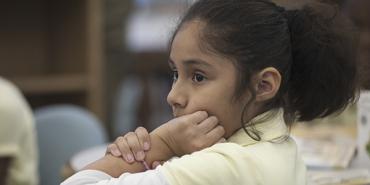In recent years, anti-immigrant sentiment and expressions of racial hostility have become more widespread and extreme. For many immigrant and undocumented students and families, neighborhood public schools have become places of refuge and security. But with school buildings closed now around the country because of the coronavirus pandemic, educators say they are concerned about how these students and families are faring.
In large cities and small rural farming areas alike, immigrant students and families rely on public schools, and trust their teachers and school employees for support that goes beyond the classroom. And many teachers and school employees are going the extra mile to help.
“Many of our immigrant families have found safety and security in our school community because of teachers and school personnel who have developed relationships with them,” says Monica Baker, an ENL (English as a new language) teacher at an elementary school in the Webutuck Central School District in New York. “There are families who’ve left their home countries to escape violence or insecurity, and some fled situations where they had to fight to meet basic survival needs. Now, they’re back to having to fight for their basic survival.”
Located in a farming community 90 miles north of New York City, the Webutuck Central School District is tackling many of the challenges facing immigrant and undocumented students in school districts around the country. Since the coronavirus forced widespread school closings about a month ago, educators say the typical impediments to teaching and learning away from classrooms—like access to technology and the internet—are compounded by additional circumstances that can be common among some immigrant and undocumented students.
Becky Corr, an ELD (English language development) team leader for public schools in Douglas County, Colo., says a big concern among her students is financial insecurity created by COVID-related job loss among immigrant parents, especially those who worked as domestic workers or in the service industry.
“With the new ‘public charge’ rule under the Trump administration, I believe families who need help are far less likely to seek that help,” Corr says. “A lot of families are worried about how to pay the rent and the mortgage.”
The problem is exacerbated by the fact that many undocumented families or those in mixed-status households—where some family members are undocumented—are hesitant to seek help from social service agencies, says Cindy Liou, state policy director for KIND (Kids in Need of Defense).
“Families find themselves in the situation where making yourself visible is how you get services, but making yourself visible also puts you at risk,” says Liou, whose agency provides legal assistance for unaccompanied children who must appear in immigration court.
On top of the ever-present struggles to meet basic living needs, some immigrant students and families must overcome a language barrier that can keep kids from participating in remote learning, says Wendy Miron, KIND’s senior director for social services.
“We have heard a number of accounts about how difficult it has been for a lot of our families to even get information on how to access the devices [for online instruction] that are being made available in some schools,” Miron says. “A lot of kids are falling behind, especially since many of them are navigating this process on their own.”
Educators also report that some students don’t have time to participate in remote learning, because they’re taking on additional responsibilities, like caring for younger siblings or elderly relatives in their homes, or even working jobs to help their families get by.
And for students and parents who are not native English speakers, trying to get through lessons and instructions for accessing online platforms that haven’t been translated can be frustrating and nearly impossible.
“We have a fairly small immigrant student population (compared to other areas of New York), but I’m really concerned about equity issues when it comes to providing online instruction for students,” says Charles Lauth, an ENL middle school teacher in Vestal, N.Y. Recognizing that not all students have equal access to online learning, Lauth’s school district initially decided to provide review and enrichment only. But that is about to change. “We plan to start providing new instruction [online], and we know some students won’t be able to participate fully.”
The barriers to remote learning are multiplied for immigrant students with physical or intellectual disabilities.
“We would like to believe that in a perfect world, students would all learn the same and perfectly, but that’s not the case,” says Lauth, a vice president of the Vestal Teachers’ Association. “We can’t use a cookie-cutter approach. We have to listen to what parents are telling us, in terms of their challenges, or we could end up being counterproductive.”
Listening to parents and overcoming the barriers to communicating with them has become an almost full-time job for many educators who have had the closest contact with immigrant students and families. A number of school districts have set up structures to facilitate regular contact between teachers and students to figure out what supports families might need.
“On an almost daily basis, I’m calling and texting families to see what help they need accessing online learning platforms, but instead of school work, a lot of those conversations turn into discussions about helping families who are out of work,” Baker says. “We’re talking about basic needs, like food. A lot of immigrant families are afraid to reach out to social services agencies, but they trust teachers, so they reach out to us.”
Baker, a member of the Webutuck Teachers’ Association, says she and her colleagues are dropping off homework packets and food to students and, in some cases, serving as liaisons between families who need help and churches and local organizations to get families what they need.
Educators in the Boston Teachers Union are working collaboratively with the school district to address the needs of students and families, including those in the immigrant and undocumented community, while schools are closed due to the coronavirus. Nora Paul-Schultz and Lena Papagiannis are two of six co-chairs of a BTU organizing committee, called Unafraid Educators, that provides advocacy for the rights of immigrant and undocumented students. They both teach at a Boston public high school.
“Parents have lost their jobs, and they don’t have money to pay the rent or buy groceries,” says Paul-Schultz, a physics teacher. “Never mind concerns about having the internet or kids trying to complete assignments.”
Since the families of undocumented students may not qualify for financial, food or housing assistance through social services, children experience stress that poses real challenges to any efforts to continue learning while schools are closed, both teachers say. That’s why Paul-Schultz and Papagiannis, together with colleagues in the BTU Unafraid Educators committee and staff, are working to create a fund that will offer financial support to the families of Boston Public School students, including immigrant, undocumented and mixed-status families who may not be eligible for other assistance.
“Most teachers are contacting students every day,” says Papagiannis, a history teacher. “A lot of our students’ families are really struggling, and they won’t be receiving a stimulus check to help. This isn’t some abstract situation. This is about our students—children who we know and care about and have relationships with.”
Days after the March 13 announcement by Boston Mayor Marty Walsh that city schools would close from March 17 through May 4, the union created the BTU Volunteer Corps to help make sure the most vulnerable students and families have access to food, services, support and child care through the COVID shutdown. Now more than 1,000 members strong, the BTU volunteers have been working with school district to get Chromebooks and meals to students.
“Immediately after the school closures were announced, our members reached out to see how they could help our families in need,” says BTU President Jessica Tang. “We’re constantly amazed by the generosity of our members and the support they’ve provided others during this crisis while they are also teaching, instructing and supporting their own children and families.”
Online resources on supporting English language learners during the coronavirus pandemic are available at AFT’s Share My Lesson and Colorín Colorado.
[Angela Callahan]


